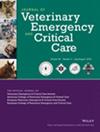Retrospective evaluation of the utility of shock index to determine the presence of congestive heart failure in dogs with myxomatous mitral valve disease (2019–2021): 98 cases
Abstract
Objectives
To calculate the shock index (SI) in dogs with myxomatous mitral valve disease (MMVD) and to evaluate its use to predict the presence of congestive heart failure (CHF).
Design
Retrospective study.
Setting
Small animal university veterinary teaching hospital.
Animals
Ninety-eight dogs with MMVD and 20 healthy dogs as part of a control group.
Interventions
Heart rate (HR) and systolic blood pressure (SBP) were recorded, and SI was calculated by dividing HR by SBP for each dog.
Measurements and Main Results
The mean (SD) HR, SBP, and SI were 123/min (32.6), 147 mm Hg (21.5), and 0.86 (0.3), respectively, for dogs with MMVD and 98/min (20.9), 145 mm Hg (18.7), and 0.68 (0.13), respectively, for control dogs. Dogs with MMVD had a significantly higher HR compared with control dogs (P < 0.01), and an elevation in HR was seen as the severity of MMVD increased. Dogs in stage B2 and C/D MMVD had a significantly higher SI value compared with control dogs (P = 0.04 and P < 0.01, respectively). SI was significantly higher in dogs in stage C/D MMVD compared with dogs in stage B2 MMVD (P < 0.01). Ten of 98 (10%) dogs had an arrhythmia. HR, SBP, and SI were not significantly different between dogs with and without arrhythmias (P = 0.13, P = 0.57, and P = 0.07, respectively), but significantly more dogs with CHF had an arrhythmia (P = 0.01). SI (area under the curve [AUC]: 0.98) and HR (AUC: 0.95) were excellent indicators for the presence of CHF. An optimal SI cutoff value ≥1.1 had 92% sensitivity and 95% specificity for predicting the presence of CHF, and an optimal HR cutoff value of ≥157/min had 92% sensitivity and 93% specificity for the prediction of CHF.
Conclusions
When there are compatible clinical signs, SI values ≥1.1 may suggest the presence of CHF in dogs with MMVD.

 求助内容:
求助内容: 应助结果提醒方式:
应助结果提醒方式:


